Microstructural Considerations of a Multi-Pass Rolled Ti-Nb-Ta-Zr Alloy
Abstract
1. Introduction
2. Materials and Methods
3. Results and Discussion
3.1. The Phase Analysis Resulted from X-ray Diffraction Investigation
3.2. The Phase Analysis Resulted from SEM Imaging
4. Conclusions
Supplementary Materials
Author Contributions
Funding
Institutional Review Board Statement
Informed Consent Statement
Data Availability Statement
Acknowledgments
Conflicts of Interest
References
- Festas, A.; Ramos, A.; Davim, J. Medical devices biomaterials—A review. Proc. Inst. Mech. Eng. L J. Mater. Des. Appl. 2020, 234, 218–228. [Google Scholar] [CrossRef]
- Carobolante, J.P.A.; Pereira Júnior, A.; Bortolini Junior, C.; Barboza da Silva, K.; Sabino, R.M.; Popat, K.C.; Claro, A.P.R.A. Processing and Characterization of a New Quaternary Alloy Ti10Mo8Nb6Zr for Potential Biomedical Applications. Materials 2022, 15, 8636. [Google Scholar] [CrossRef] [PubMed]
- Wang, H.; Yuan, X.; Wu, K.; Xu, C.; Jiao, Y.; Ge, W.; Luo, J. Effect of high energy shot-peening on the microstructure and mechanical properties of Al5052/Ti6Al4V lap joints. J. Mater. Process. Technol. 2018, 255, 76–85. [Google Scholar] [CrossRef]
- Zheng, Y.; Wang, D.; Banerjee, R.; Banerjee, D.; Wang, Y.; Fraser, H.L. Exploration of Nano-scale Structural Instabilities in Metastable β Titanium Alloys Using Advanced Electron Microscopy. In MATEC Web of Conferences; EDP Sciences: Les Ulis, France, 2020; Volume 321, p. 12001. [Google Scholar]
- Wang, T.; Feng, Y.; Liu, X.; Wang, K.; Li, S.; Zhao, F. Phase Composition Effects on Dynamic Behavior and Strain Rate Sensitivity in Metastable β-Ti Alloys. Materials 2022, 15, 4068. [Google Scholar] [CrossRef] [PubMed]
- Li, Y.; Yang, C.; Zhao, H.; Qu, S.; Li, X.; Li, Y. New Developments of Ti-Based Alloys for Biomedical Applications—A review. Materials 2014, 7, 1709–1800. [Google Scholar] [CrossRef]
- Niinomi, M.; Nakai, M.; Hieda, J. Development of new metallic alloys for biomedical applications. Acta Biomater. 2012, 8, 3888–3903. [Google Scholar] [CrossRef]
- Capellato, P.; Vilela, F.B.; Fontenele, A.H.P.; da Silva, K.B.; Carobolante, J.P.A.; Bejarano, E.G.M.; de Lourdes Noronha Motta Melo, M.; Claro, A.P.R.A.; Sanchs, D. Evaluation of microstructure and mechanical properties of a Ti10Mo8Nb alloy for biomedical applications. Metals 2022, 12, 1065. [Google Scholar] [CrossRef]
- Zhang, S.; Wang, Q.; Cheng, X.; Han, J.; Zhang, W.; Zhang, C.; Wu, J. Static Recrystallization Behavior and Texture Evolution during Annealing in a Cold Rolling Beta Titanium Alloy Sheet. Metals 2022, 12, 899. [Google Scholar] [CrossRef]
- Qu, W.; Sun, X.; Yuan, B.; Xiong, C.; Zhang, F.; Li, Y.; Sun, B. Microstructures and phase transformations of Ti-30Zr-xNb (x = 5, 7, 9, 13 at.%) shape memory alloys. Mater. Charact. 2016, 122, 1–5. [Google Scholar] [CrossRef]
- Keshtta, A.; Gepreel, M.A.H. Superelasticity Evaluation of the Biocompatible Ti-17Nb-6Ta Alloy. J. Healthc. Eng. 2019, 2019, 8353409. [Google Scholar] [CrossRef]
- Ozan, S.; Lin, J.; Li, Y.; Wen, C. New Ti-Ta-Zr-Nb alloys with ultrahigh strength for potential orthopedic implant applications. J. Mech. Behav. Biomed. Mater. 2017, 75, 119–127. [Google Scholar] [CrossRef] [PubMed]
- Gepreel, M.A.; Niinomi, M. Biocompatibility of Ti-alloys for long-term implantation. J. Mech. Behav. Biomed. Mater. 2013, 20, 407–415. [Google Scholar] [CrossRef]
- Kopova, I.; Stráský, J.; Harcuba, P.; Landa, M.; Janeček, M.; Bačákova, L. Newly developed Ti–Nb–Zr–Ta–Si–Fe biomedical beta titanium alloys with increased strength and enhanced biocompatibility. Mater. Sci. Eng. C 2016, 60, 230–238. [Google Scholar] [CrossRef] [PubMed]
- Slokar, L.; Štrkalj, A.; Glavaš, Z. Synthesis of Ti-Zr alloy by powder metallurgy. Eng. Rev. 2019, 39, 115–123. [Google Scholar] [CrossRef]
- Medvedev, A.E.; Molotnikov, A.; Lapovok, R.; Zeller, R.; Berner, S.; Habersetzer, P.; Torre, F.D. Microstructure and mechanical properties of Ti–15Zr alloy used as dental implant material. J. Mech. Behav. Biomed. Mater. 2016, 62, 384–398. [Google Scholar] [CrossRef]
- Grandin, H.M.; Berner, S.; Dard, M. A review of Titanium Zirconium (TiZr) alloys for use in endosseous dental implants. Materials 2012, 5, 1348–1360. [Google Scholar] [CrossRef]
- Pang, E.L.; Pickering, E.J.; Baik, S.I.; Seidman, D.N.; Jones, N.G. The effect of zirconium on the omega phase in Ti-24Nb-[0–8]Zr (at.%) alloys. Acta Mater. 2018, 153, 62–70. [Google Scholar] [CrossRef]
- Sulkowski, B.; Panigrahi, A.; Ozaltin, K.; Lewandowska, M.; Mikułowski, B.; Zehetbauer, M. Evolution of strength and structure during SPD processing of Ti-45Nb alloys: Experiments and simulations. J. Mater. Sci. 2014, 49, 6648. [Google Scholar] [CrossRef]
- Zhang, J.; Li, J.; Chen, G.; Liu, L.; Chen, Z.; Meng, Q.; Shen, B.; Sun, F.; Prima, F. Fabrication and characterization of a novel β metastable Ti-Mo-Zr alloy with large ductility and improved yield strength. Mater. Charact. 2018, 139, 421–427. [Google Scholar] [CrossRef]
- Niinomi, M.; Nakai, M.; Hendrickson, M.; Nandwana, P.; Alam, T.; Choudhuri, D.; Banerjee, R. Influence of oxygen on omega phase stability in the Ti-29Nb-13Ta-4.6Zr alloy. Scripta Mater. 2016, 123, 144–148. [Google Scholar] [CrossRef]
- Xie, K.Y.; Wang, Y.B.; Zhao, Y.H.; Chang, L.; Wang, G.C.; Chen, Z.B.; Cao, Y.; Liao, X.Z.; Lavernia, E.J.; Valiev, R.Z.; et al. Nanocrystalline β-Ti alloy with high hardness, low Young’s modulus and excellent in vitro biocompatibility for biomedical applications. Mater. Sci. Eng. C 2013, 33, 3530–3536. [Google Scholar] [CrossRef]
- Zhao, D.; Ebel, T.; Yan, M.; Qian, M. Trace Carbon in Biomedical Beta-Titanium Alloys: Recent Progress. JOM 2015, 67, 2236. [Google Scholar] [CrossRef]
- Sun, J.; Ke, Q.; Chen, W. Material instability under localized severe plastic deformation during high-speed turning of titanium alloy Ti-6.5AL-2Zr-1Mo-1V. J. Mater. Process Technol. 2019, 264, 119. [Google Scholar] [CrossRef]
- Niinomi, M.; Yi, L.; Nakai, M.; Liu, H.; Hua, L. Biomedical titanium alloys with Young’s moduli close to that of cortical bone. Regener. Biomater. 2016, 3, 173–185. [Google Scholar] [CrossRef]
- Matlakhova, L.A.; Matlakhov, A.N.; Monteiro, S.N.; Fedotov, S.G.; Goncharenko, B.A. Properties and structural characteristics of Ti–Nb–Al alloys. Mater. Sci. Eng. A 2005, 393, 320–326. [Google Scholar] [CrossRef]
- Zhou, Y.L.; Niinomi, M.; Akahori, T. Effects of Ta content on Young’s modulus and tensile properties of binary Ti–Ta alloys for biomedical applications. Mater. Sci. Eng. A 2004, 371, 283. [Google Scholar] [CrossRef]
- Majchrowicz, K.; Sotniczuk, A.; Malicka, J.; Choinska, E.; Garbacz, H. Thermal Stability and Mechanical Behavior of Ultrafine-Grained Titanium with Different Impurity Content. Materials 2023, 16, 1339. [Google Scholar] [CrossRef]
- Kriegel, M.J.; Rudolph, M.; Kilmametov, A.; Straumal, B.B.; Ivanisenko, J.; Fabrichnaya, O.; Hahn, H.; Rafaja, D. Formation and Thermal Stability of ω-Ti(Fe) in α-Phase-Based Ti(Fe) Alloys. Metals 2020, 10, 402. [Google Scholar] [CrossRef]
- Sajadifar, S.V.; Maier, H.J.; Niendorf, T.; Yapici, G.G. Elevated Temperature Mechanical Characteristics and Fracture Behavior of a Novel Beta Titanium Alloy. Crystals 2023, 13, 269. [Google Scholar] [CrossRef]
- Hao, Y.L.; Yang, R.; Niinomi, M.; Kuroda, D.; Zhou, Y.L.; Fukunaga, K.; Suzuki, A. Young’s modulus and mechanical properties of Ti-29Nb-13Ta-4.6Zr in relation to α″ martensite. Metall. Mater. Trans. A 2002, 33, 3137–3144. [Google Scholar] [CrossRef]
- Haftlang, F.; Zarei-Hanzaki, A.; Abedi, H.R.; Kalaei, M.A.; Nemecek, J.; Málek, J. Room-temperature micro and macro mechanical properties of the metastable Ti–29Nb–14Ta–4.5Zr alloy holding nano-sized precipitates. Mater. Sci. Eng. A 2019, 771, 138583. [Google Scholar] [CrossRef]
- Baltatu, M.S.; Vizureanu, P.; Geanta, V.; Tugui, C.A.; Voiculescu, I. Mechanical tests for Ti-based alloys as new medical materials. IOP Conf. Ser. Mater. Sci. Eng. 2019, 572, 012029. [Google Scholar] [CrossRef]
- Kolli, R.P.; Devaraj, A. A Review of Metastable Beta Titanium Alloys. Metals 2018, 8, 506. [Google Scholar] [CrossRef]
- Hua, K.; Zhang, Y.; Tong, Y.; Zhang, F.; Kou, H.; Li, X.; Wang, H.; Li, J. Enhanced mechanical properties of a metastable β titanium alloy via optimized thermomechanical processing. Mater. Sci. Eng. A 2022, 840, 142997. [Google Scholar] [CrossRef]
- Valiev, R.Z.; Estrin, Y.; Horita, Z.; Langdon, T.G.; Zehetbauer, M.J.; Zhu, Y.T. Fundamentals of superior properties in bulk nano SPD materials. Mater. Res. Lett. 2016, 4, 1–21. [Google Scholar] [CrossRef]
- Yilmazer, H.; Niinomi, M.; Nakai, M.; Cho, K.; Hieda, J.; Todaka, Y.; Miyazaki, T. Mechanical properties of a medical β-type titanium alloy with specific microstructural evolution through high-pressure torsion. Mater. Sci. Eng. C 2013, 33, 2499–2507. [Google Scholar] [CrossRef]
- Lin, Z.; Wang, L.; Xue, X.; Lu, W.; Qin, J.; Zhang, D. Microstructure evolution and mechanical properties of a Ti–35Nb–3Zr–2Ta biomedical alloy processed by equal channel angular pressing (ECAP). Mater. Sci. Eng. C 2013, 33, 4551–4561. [Google Scholar] [CrossRef]
- Wang, Y.; Zhao, J.; Dai, S.; Chen, F.; Yu, X.; Zhang, Y. Influence of cold rolling and ageing treatment on microstructure and mechanical properties of Ti-30Nb-5Ta-6Zr alloy. J. Mech. Behav. Biomed. Mater. 2013, 27, 33–42. [Google Scholar] [CrossRef]
- Yang, Y.; Wu, S.Q.; Li, G.P. Evolution of deformation mechanisms of Ti–22.4Nb–0.73Ta–2Zr–1.34O alloy during straining. Acta Mater. 2010, 58, 2778. [Google Scholar] [CrossRef]
- Angelescu, M.L.; Dan, A.; Ungureanu, E.; Zarnescu-Ivan, N.; Galbinasu, B.M. Effects of Cold Rolling Deformation and Solution Treatment on Microstructural, Mechanical, and Corrosion Properties of a Biocompatible Ti-Nb-Ta-Zr Alloy. Metals 2022, 12, 248. [Google Scholar] [CrossRef]
- Valiev, R.Z.; Estrin, Y.; Horita, Z.; Langdon, T.G.; Zehetbauer, M.J.; Zhu, Y.T. Producing bulk ultrafine-grained materials by severe plastic deformation: Ten years later. JOM 2016, 68, 1216–1226. [Google Scholar] [CrossRef]
- Raducanu, D.; Cojocaru, V.D.; Nocivin, A.; Cinca, I.; Serban, N.; Cojocaru, E.M. Contributions to Mechanical Characteristics Improvement of Some Biomedical TNTZ Alloys by Adding Fe, Si, and O: A Comparative Study. JOM 2019, 71, 264–271. [Google Scholar] [CrossRef]
- Valiev, R.Z.; Prokofiev, E.A.; Kazarinov, N.A.; Raab, G.I.; Minasov, T.B.; Stráský, J. Developing Nanostructured Ti Alloys for Innovative Implantable Medical Devices. Materials 2020, 13, 967. [Google Scholar] [CrossRef]
- Nocivin, A.; Raducanu, D.; Vasile, B.; Trisca-Rusu, C.; Cojocaru, E.M.; Dan, A.; Irimescu, R.; Cojocaru, V.D. Tailoring a Low Young Modulus for a Beta Titanium Alloy by Combining Severe Plastic Deformation with Solution Treatment. Materials 2021, 14, 3467. [Google Scholar] [CrossRef]
- Raducanu, D.; Cojocaru, V.D.; Nocivin, A.; Cinca, I.; Serban, N.; Cojocaru, E.M. Beta-Phase Stability of Two Biomedical b-Titanium Alloys during Severe Plastic Deformation. JOM 2020, 72, 2937–2948. [Google Scholar] [CrossRef]
- Nocivin, A.; Raducanu, D.; Cinca, I.; Trisca-Rusu, C.; Butu, M.; Thibon, I.; Cojocaru, V.D. X-ray Diffraction Study and Texture Evolution for a Ti-Nb-Ta Biomedical Alloy processed by Accumulative Roll Bonding. J. Mater. Eng. Perform. 2015, 24, 1587–1601. [Google Scholar] [CrossRef]
- Soundararajan, S.R.; Vishnu, J.; Manivasagam, G.; Muktinutalapati, N.R. Heat Treatment of Metastable Beta Titanium Alloys. In Metal Heat Treatments; IntechOpen: London, UK, 2020; Available online: https://www.intechopen.com/chapters/72078 (accessed on 10 January 2023). [CrossRef]
- Naresh Kumar, K.; Muneshwar, P.; Singh, S.K.; Jha, A.K.; Pant, B. Thermomechanical working and heat treatment studies on meta-stable beta titanium alloy (Ti15V3Al3Sn3Cr) plates. Mater. Sci. Forum. 2015, 830–831, 151–155. [Google Scholar] [CrossRef]
- Neelakantan, S.; Rivera-Diaz-del-Castillo, P.E.J.; van der Zwaag, S. Prediction of the martensite start temperature for beta titanium alloys as a function of composition. Scripta Mater. 2009, 60, 611–614. [Google Scholar] [CrossRef]
- Hendri, H.; Abdullah, B.; Tahir, D. Analysis of structural properties of X-ray diffraction for composite copper-activated carbon by modified Williamson-Hall and size-strain plotting methods. J. Phys. Conf. Ser. 2018, 1080, 012007. [Google Scholar]
- Ahmed, M.; Wexler, D.; Casillas, G.; Ivasishin, O.M.; Pereloma, E.V. The influence of β phase stability on deformation mode and compressive mechanical properties of Ti-10V-3Fe-3Al alloy. Acta Mater. 2015, 84, 124–135. [Google Scholar] [CrossRef]
- Azadmanjiri, J.; Berndt, C.C.; Kapoor, A.; Wen, C. Development of Surface Nano-Crystallization in Alloys by Surface Mechanical Attrition Treatment (SMAT). Crit. Rev. Solid State Mater. Sci. 2015, 40, 164–181. [Google Scholar] [CrossRef]
- Ma, X.; Chen, Z.; Xiao, L.; Lu, W.; Luo, S.; Mi, Y. Compressive deformation of a metastable β titanium alloy undergoing a stress-induced martensitic transformation: The role of β grain size. Mater. Sci. Eng. A 2020, 794, 139919. [Google Scholar] [CrossRef]
- Wang, Q.; Ren, J.Q.; Xin, C.; Sang, B.; Chen, D.J.; Lu, X.F.; Zhang, L.; Zhang, Y.H. Charpy impact behaviors of metastable β-Ti alloys: Transformation induce plasticity versus twining induce plasticity. Mater. Sci. Eng. A 2023, 867, 144753. [Google Scholar] [CrossRef]
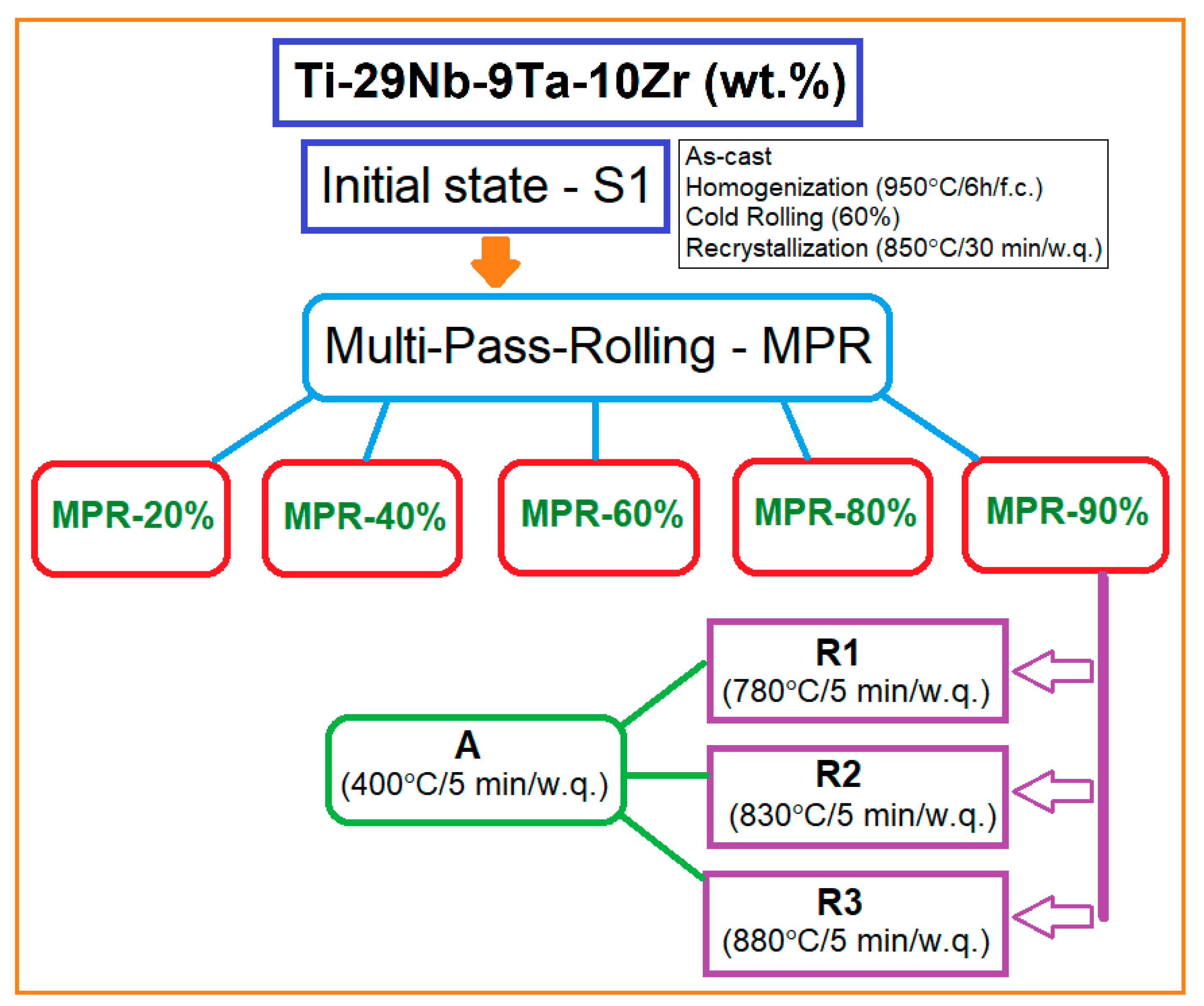
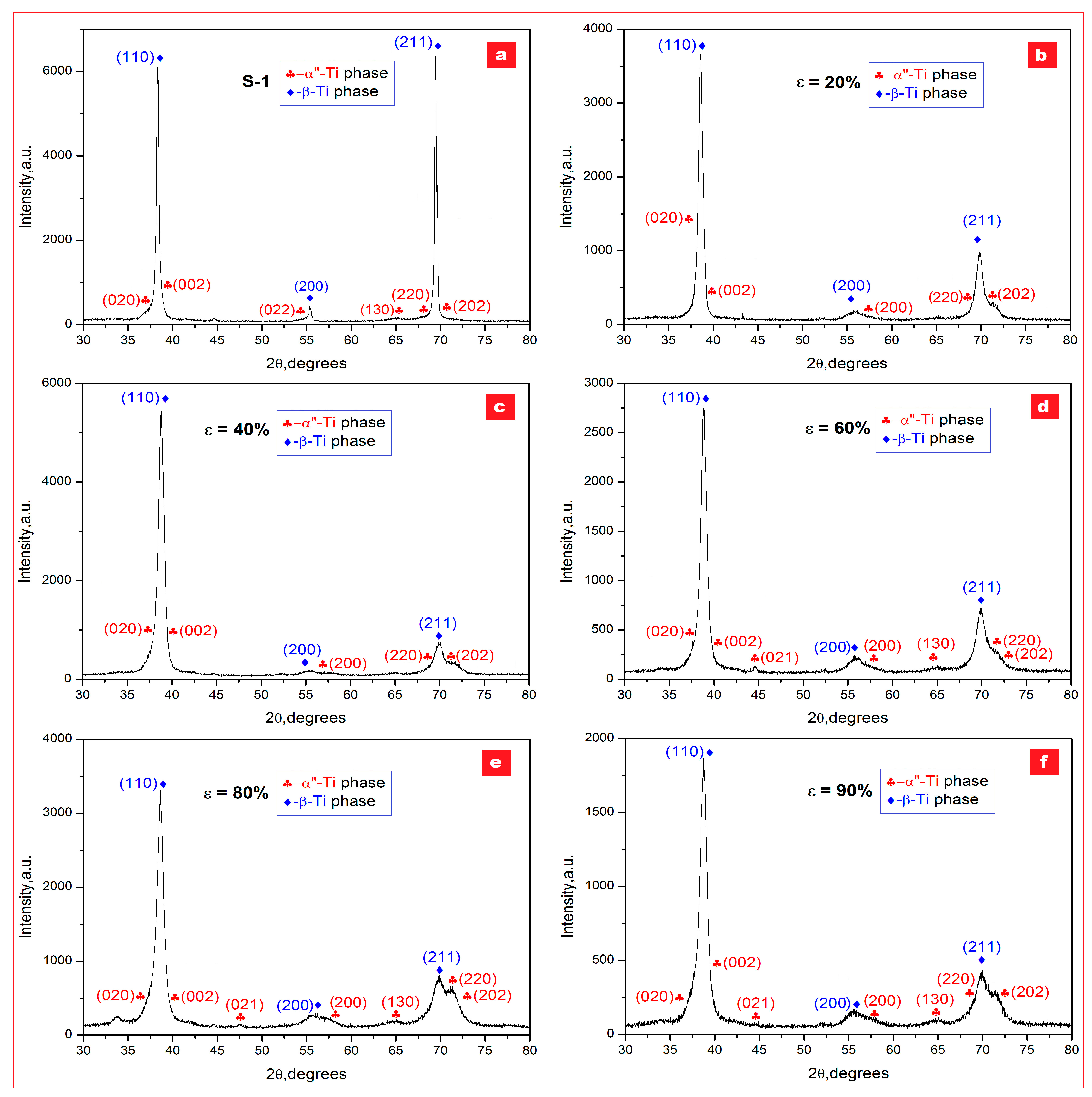
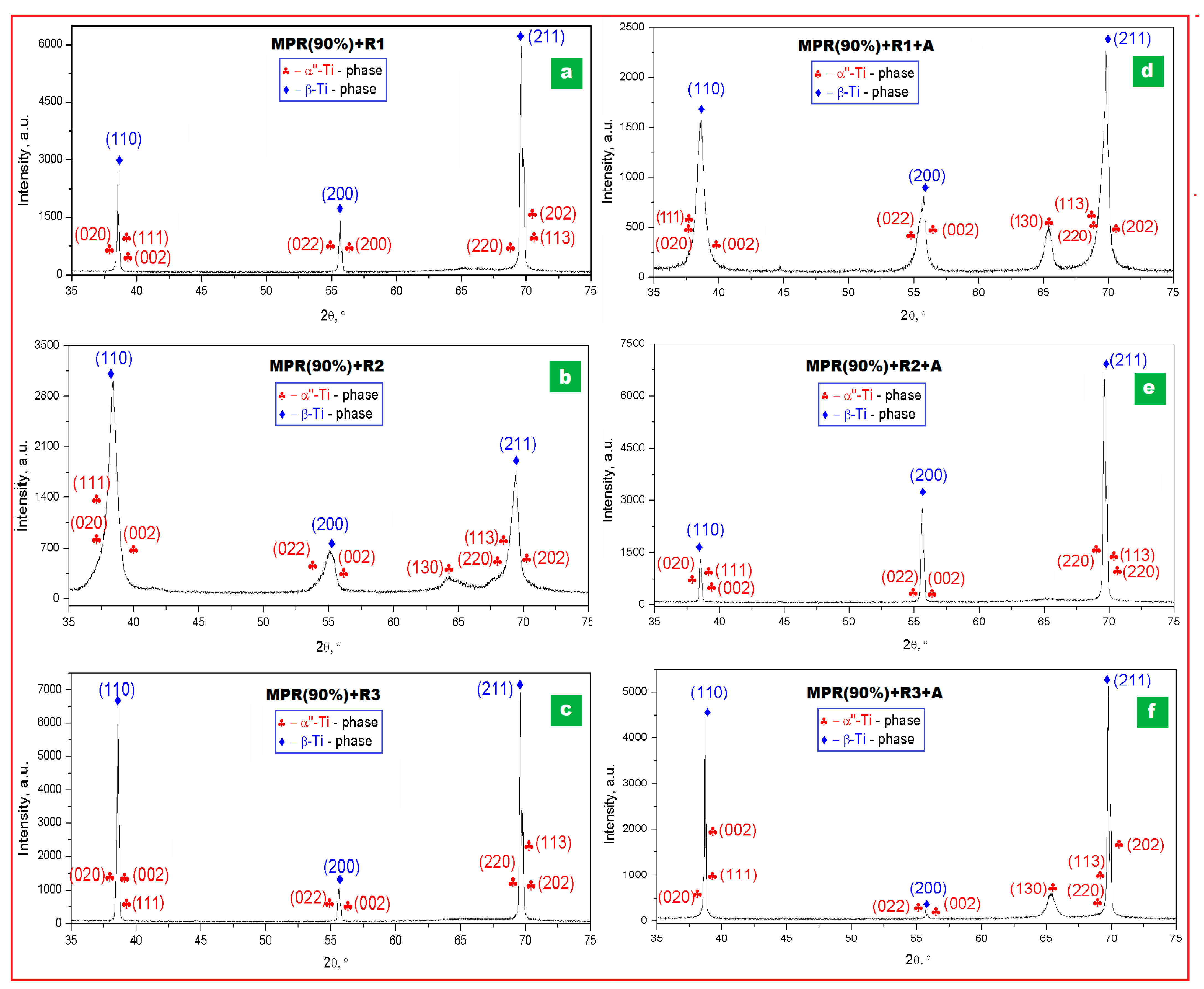
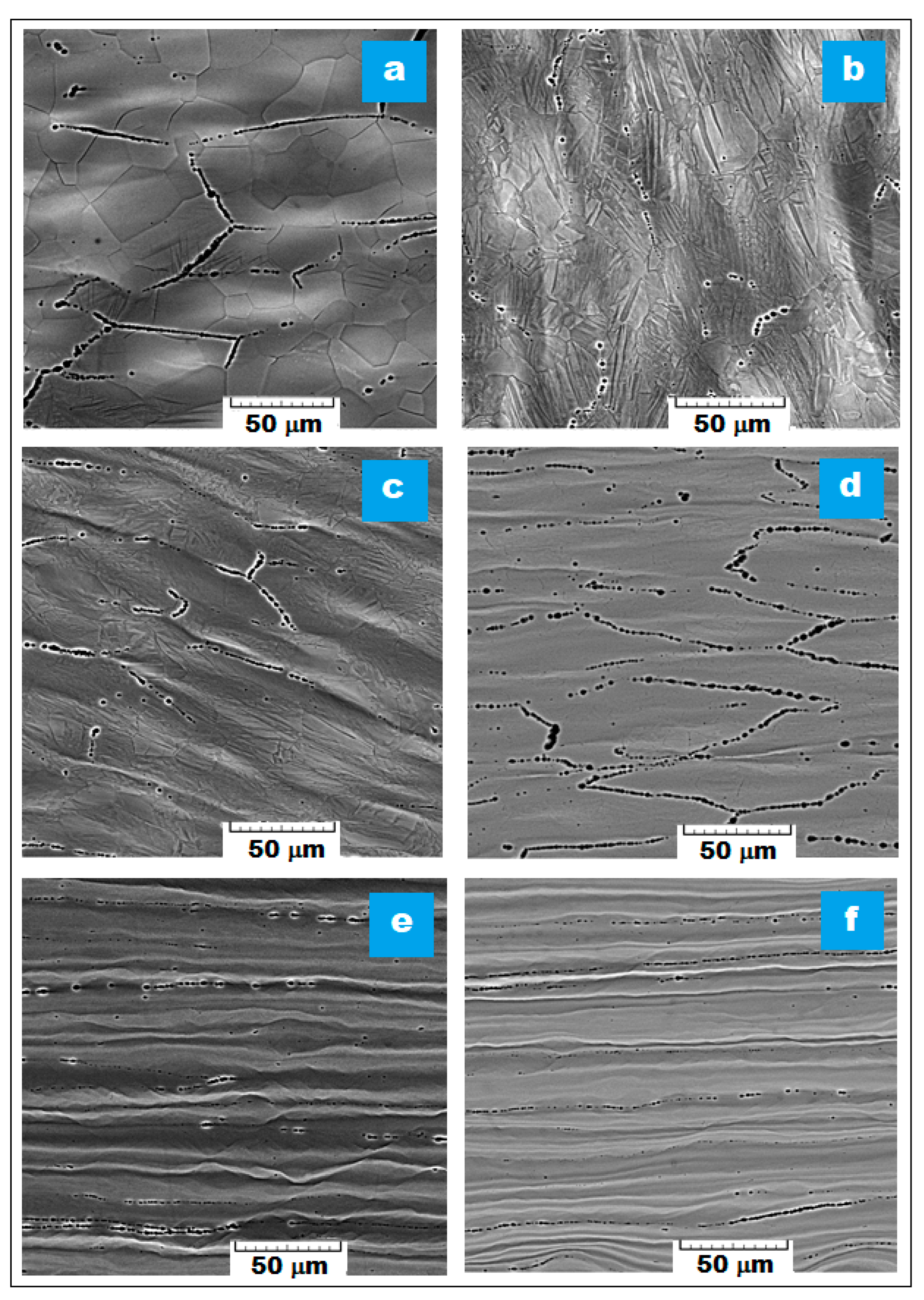
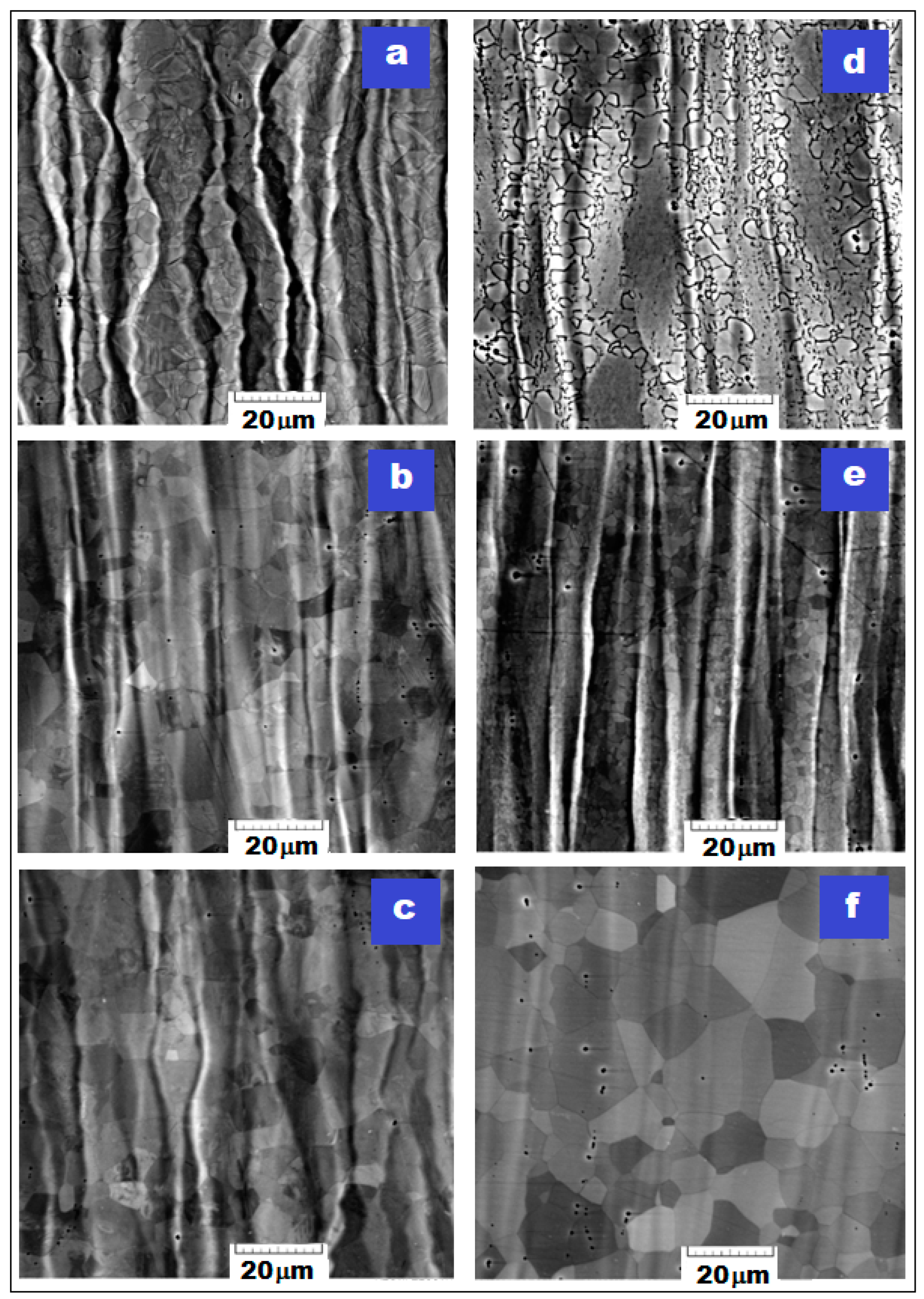
| Structural State | β-Ti Phase | α″-Ti Phase | ||
|---|---|---|---|---|
| a [nm] | a [nm] | b [nm] | c [nm] | |
| S-1: Initial Sample | 0.330 | 0.329 | 0.478 | 0.462 |
| MPR (εtot = 20%) | 0.330 | 0.323 | 0.474 | 0.462 |
| MPR (εtot = 40%) | 0.330 | 0.323 | 0.472 | 0.462 |
| MPR (εtot = 60%) | 0.330 | 0.321 | 0.470 | 0.460 |
| MPR (εtot = 80%) | 0.330 | 0.322 | 0.472 | 0.462 |
| MPR (εtot = 90%) | 0.329 | 0.321 | 0.471 | 0.461 |
| MPR (εtot = 90%) + R1 | 0.331 | 0.330 | 0.476 | 0.466 |
| MPR (εtot = 90%) + R2 | 0.331 | 0.333 | 0.479 | 0.469 |
| MPR (εtot = 90%) + R3 | 0.330 | 0.326 | 0.476 | 0.448 |
| MPR (εtot = 90%) + R1 + A | 0.330 | 0.326 | 0.477 | 0.469 |
| MPR (εtot = 90%) + R2 + A | 0.331 | 0.331 | 0.475 | 0.465 |
| MPR (εtot = 90%) + R3 + A | 0.330 | 0.333 | 0.478 | 0.464 |
| Structural State | β-Ti Phase | α″-Ti Phase | ||||
|---|---|---|---|---|---|---|
| ε [%] | D [nm] | Phase’s % | ε [%] | D [nm] | Phase’s % | |
| S-1: Initial Sample | 0.05 | 26.92 | 99.52 ± 0.61% | 0.06 | - | 0.48 ± 0.12% |
| MPR (εtot = 20%) | 0.28 | 24.16 | 97.79 ± 1.17% | 0.22 | 7.32 | 2.21 ± 0.68% |
| MPR (εtot = 40%) | 0.26 | 11.72 | 94.19 ± 1.84% | 0.28 | 6.84 | 5.81 ± 1.09% |
| MPR (εtot = 60%) | 0.14 | 11.48 | 91.38 ± 1.31% | 0.35 | 8.43 | 8.62 ± 1.01% |
| MPR (εtot = 80%) | 0.18 | 10.19 | 89.67 ± 1.27% | 0.89 | 7.65 | 10.33 ± 1.89% |
| MPR (εtot = 90%) | 0.22 | 9.84 | 89.35 ± 1.48% | 0.92 | 9.12 | 10.65 ± 1.04% |
| MPR (εtot = 90%) + R1 | 0.36 | 108.22 | 95.54 ± 0.85% | 0.44 | 9.33 | 4.46 ± 0.66% |
| MPR (εtot = 90%) + R2 | 0.39 | 112.63 | 97.15 ± 0.94% | 0.42 | 9.64 | 2.85 ± 0.38% |
| MPR (εtot = 90%) + R3 | 0.40 | 138.65 | 97.87 ± 1.25% | 0.41 | 10.08 | 2.13 ± 0.07% |
| MPR (εtot = 90%) + R1 + A | 0.04 | 138.82 | 93.66 ± 1.34% | 0.06 | 9.31 | 6.34 ± 0.54% |
| MPR (εtot = 90%) + R2 + A | 0.07 | 156.76 | 97.73 ± 0.96% | 0.04 | 7.83 | 2.27 ± 0.11% |
| MPR (εtot = 90%) + R3 + A | 0.09 | 186.33 | 97.94 ± 0.47% | 0.04 | 8.24 | 2.06 ± 0.09% |
Disclaimer/Publisher’s Note: The statements, opinions and data contained in all publications are solely those of the individual author(s) and contributor(s) and not of MDPI and/or the editor(s). MDPI and/or the editor(s) disclaim responsibility for any injury to people or property resulting from any ideas, methods, instructions or products referred to in the content. |
© 2023 by the authors. Licensee MDPI, Basel, Switzerland. This article is an open access article distributed under the terms and conditions of the Creative Commons Attribution (CC BY) license (https://creativecommons.org/licenses/by/4.0/).
Share and Cite
Răducanu, D.; Nocivin, A.; Cojocaru, V.D.; Șerban, N.; Zărnescu-Ivan, N.; Irimescu, R.E.; Gălbinașu, B.M. Microstructural Considerations of a Multi-Pass Rolled Ti-Nb-Ta-Zr Alloy. Materials 2023, 16, 3208. https://doi.org/10.3390/ma16083208
Răducanu D, Nocivin A, Cojocaru VD, Șerban N, Zărnescu-Ivan N, Irimescu RE, Gălbinașu BM. Microstructural Considerations of a Multi-Pass Rolled Ti-Nb-Ta-Zr Alloy. Materials. 2023; 16(8):3208. https://doi.org/10.3390/ma16083208
Chicago/Turabian StyleRăducanu, Doina, Anna Nocivin, Vasile Dănuț Cojocaru, Nicolae Șerban, Nicoleta Zărnescu-Ivan, Raluca Elena Irimescu, and Bogdan Mihai Gălbinașu. 2023. "Microstructural Considerations of a Multi-Pass Rolled Ti-Nb-Ta-Zr Alloy" Materials 16, no. 8: 3208. https://doi.org/10.3390/ma16083208
APA StyleRăducanu, D., Nocivin, A., Cojocaru, V. D., Șerban, N., Zărnescu-Ivan, N., Irimescu, R. E., & Gălbinașu, B. M. (2023). Microstructural Considerations of a Multi-Pass Rolled Ti-Nb-Ta-Zr Alloy. Materials, 16(8), 3208. https://doi.org/10.3390/ma16083208







